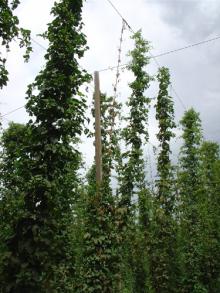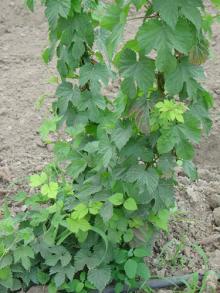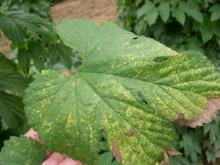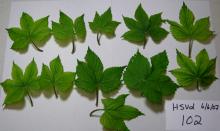By K. Eastwell, D. H. Gent, and C. M. Ocamb
Cause Hop latent viroid (HLVd) and hop stunt viroid (HSVd) have been confirmed in the Pacific Northwest. HLVd is ubiquitous in hop yards in the Pacific Northwest and worldwide, but only produces known symptoms on a few varieties, such as 'Omega'. It is not known to cause yield loss in varieties grown in the Pacific Northwest. However, HLVd is problematic on industrial hemp and other types of cannabis. HSVd was confirmed in the Pacific Northwest in 2004 onward on a wide range of varieties, including 'Glacier', 'Mt. Hood', 'Nugget', 'Sterling' and 'Willamette' in both Oregon and Washington. HSVd can also occur in grape and mulberry plants. The viroid is spread mechanically during propagation, field operations, and to a limited degree by plant-to-plant contact.
Symptoms HLVd-infected plants have no known symptoms on varieties grown in the Pacific Northwest. Symptoms of HLVd on variety 'Omega' appear as a yellowing and curling of leaves. Necrosis of leaves and leaf margins is common. Infected plants are stunted, have shortened internodes, and in general have an unthrifty appearance. Yield losses can be significant.
The symptomology of HSVd is not well known for most hop varieties grown in the Pacific Northwest. In some varieties such as 'Glacier', HSVd causes a stunting of plants, yellowing, and curling of the upper leaves. On other varieties there may be a yellow speckling of leaves, and sidearm stunting or dieback. Plant height may be reduced by 40% as compared to noninfected plants. The severity of symptoms may become progressively greater with time. On susceptible varieties, the number of cones produced and cone size are reduced by as much as 50% to 75%. The alpha-acid content of cones that are produced is one-half to one-third of that in cones from healthy plants.
Plantings with high levels of Hop stunt also have been observed to have very high incidences of Fusarium canker and the presence of canker may lead to the discovery of the viroid disease in hop varieties more tolerant of hop stunt viroid infection.
Cultural control Exclusion is an important means of viroid control.
- Use viroid-tested stock certified to be free of viroids.
- Clean rootstock is available from the Clean Plant Center Northwest at https://cpcnw.wsu.edu/
- Plant where hops have not been grown before or in fields where all hop plants have died out.
- General sanitation for disease control.
- Work/harvest diseased yards last.
- Clean equipment between yards, particularly during early season operations. Currently, it is recommended that equipment be cleaned by first washing to remove plant debris and then with a 5% to 10% bleach solution for at least a few seconds to upwards of 10 minutes. The longer time the equipment can be in contact with the disinfecting solution, the greater the likelihood that the equipment will be sanitized. Because the bleach is so caustic to metals, it may be good idea to rinse equipment with clean water after sanitizing.
- Destroy plants that are severely stunted or yellowed. It is recommended that you wait at least one season after infected plants are removed before replanting to hop to ensure that all of the infected hop plants have been eliminated. When replanting, it will be important to plant with stock that has been tested for hop stunt viroid and shown to be free of the viroid.
References Cerruti, N. 2010. Examinations of Fusarium sambucinum on Humulus lupulus and Co-infection with hop stunt viroid in Commercial Hop Fields. M.S. thesis, Oregon State University, Corvallis, OR.
Eastwell, K.C., and Nelson, M.E. 2007. Occurrence of viroids in commercial hop (Humulus lupulus L.) production areas of Washington state. Plant Health Progress doi:10.1094/PHP-2007-1127-01-RS.
Pethybridge, S.J., et al. 2008. Viruses and viroids infecting hop: significance, epidemiology, and management. Plant Disease 92(3):324-338.





